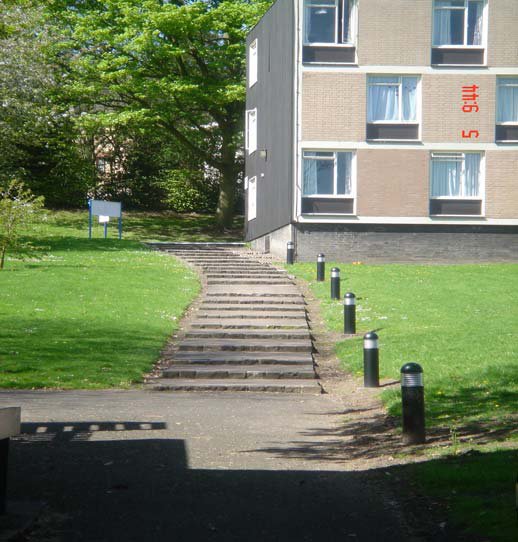
stairs etc
Yes
Yes
No
No
Falling on
Vulnerable age
Related hazards
Persons aged 60 years and over
None
Multiple locations
Secondary hazards
DESCRIPTION OF HAZARDS
DWELLING: A ground floor flat in a block of student flats
constructed in 1996
Background: The ground floor unit is one of a number of cluster flats in a hall of residence. There is an
access road in front of the block (not shown) and a series of raised sections (see photograph) with a
consistent rise of 75mm per section. The treads are paving slabs. The bollards to the right of the path provide
some illumination, but do not effectively illuminate each of the treads. The treads to the steps slope forwards
and there are slight variations in the depth of treads.
LIST OF RELEVANT MATTERS
LIKELIHOOD & OUTCOMES
a
Tread lengths
b
Riser heights
c
Variations in treads and risers
d
Nosing length
e
Poor friction quality
f
Openings in stairs alternating treads
g
Lack/height handrails
h
Lack/ height guarding
i
Stair width
j
Length of flight
k
Inadequate lighting
l
Doors onto stairs
m
Inadequate landing
L
2
2
1
O
L
n
Construction/repair
-
o
Thermal efficiency
-
Outcomes
21 (IDeA - 01)
June 2006
HHSRS 06/06
Pitch of stairs
Projections
-
Hard surfaces
-
-
-
3
-
1
3
3
3
-
-
O
-
-
1
3
a
b
c
# Compounding matters
None
A
B
-
-
Key
3
Seriously defective
2
Defective
1
Not satisfactory
-
Satisfactory/NA
21 (IDeA - 01)
June 2006
HEALTH AND SAFETY RATING SYSTEM SCORES
LIKELIHOOD
Low
High
1 in 32
Av Post 1979 Flats: 409
32
< 4200 2400 1300 750 420 240 130
75
42
24
13
7.5
4
2.5
1.5 >
Justification
The common access path is made up of a series of at least 20 steps which have shallow
risers. The long but variable tread depths combined with minimal rise, the slight forward
slope of the treads, and poor illumination across the width of the treads increase the
likelihood of a misstep, particularly in icy weather. These factors, together with the lack of a
handrail to save a misstep resulting in a fall, increases the likelihood of an occurrence over
the next twelve months.
OUTCOMES
%
Av Post 1979: 2.6
Class I
4.6
< 0.05 0.15 0.3
0.7
1.5
3
7
15
26
38 >
Av: 5.2
Class II
10
< 0.05 0.15 0.3
0.7
1.5
3
7
15
26
38 >
Av: 19.4
Class III
21.5
< 0.05 0.15 0.3
0.7
1.5
3
7
15
26
38 >
Av: 72.8
Class IV
63.9
< 0.05 0.15 0.3
0.7
1.5
3
7
15
26
38 >
Justification
The presence of the external front steps to the block containing the flat, concrete flags,
together with their rough edges significantly increase the risk of a fatal or severe fall
occurring, particularly in cold weather or at night.
Av. Post 1979 Flats: 92
RATING
A
B
C
D
E
F
G
H
I
J
Score:
1971
RATING SCORES AFTER IMPROVEMENT
IMPROVE
Likelihood to
1 in
320
Outcomes to
2.2 10.0 21.5 66.3
%
Justification
Provision of full handrails to both sides of the steps, plus improved artificial lighting and
providing more consistent tread depths, would give a nearer the average likelihood of a
major fall. The steps are still external and the spread of health outcomes reflects the
situation; the presence of handrails may also reduce chance of a Class 1 harm, but Class
II harm would still be more likely than average
Av: 92
NEW RATING
A
B
C
D
E
F
G
H
I
J
Score:
122
Av: Nos
Average likelihood and health outcomes for all persons aged 60 years and over,1997-99.